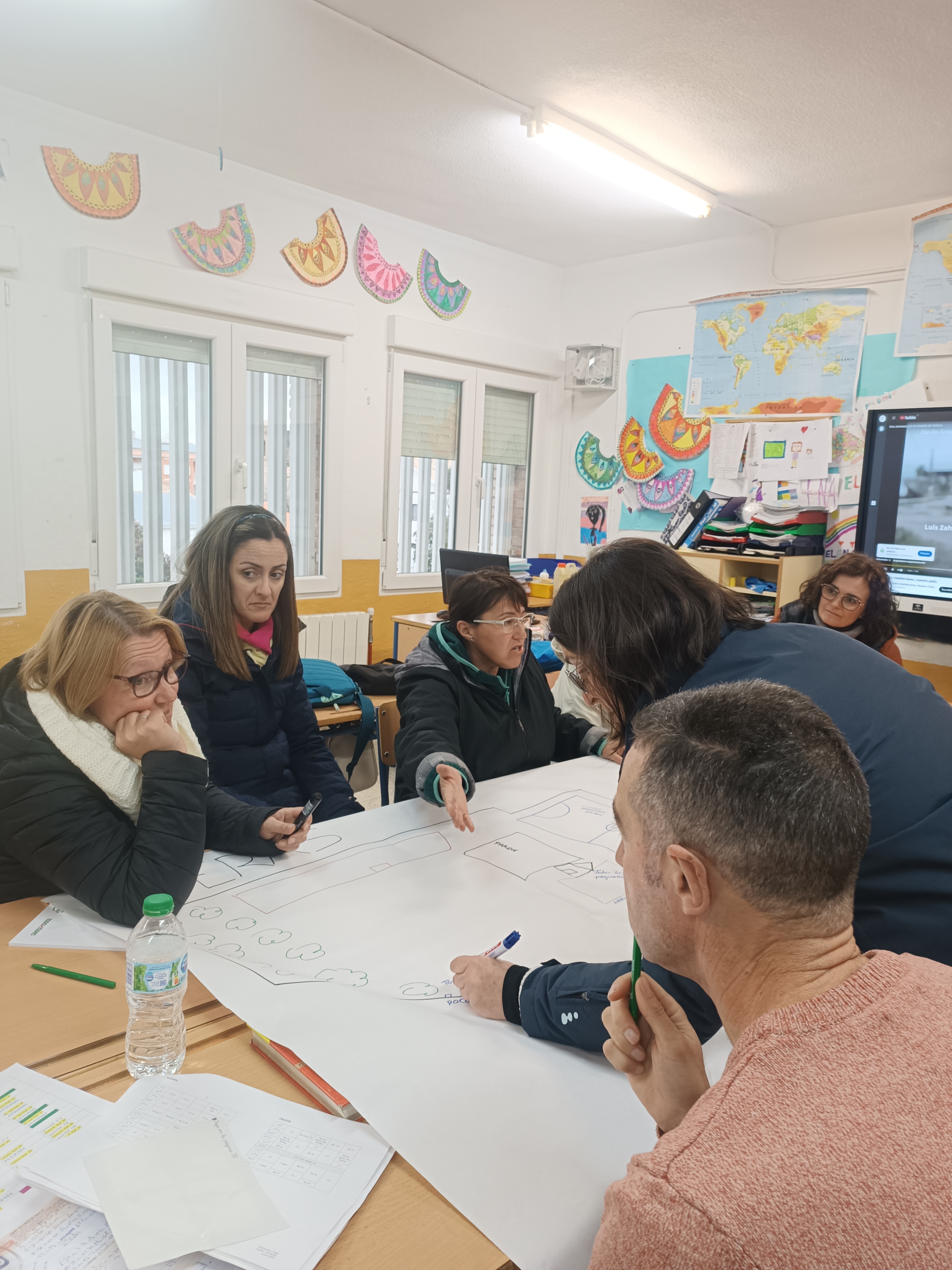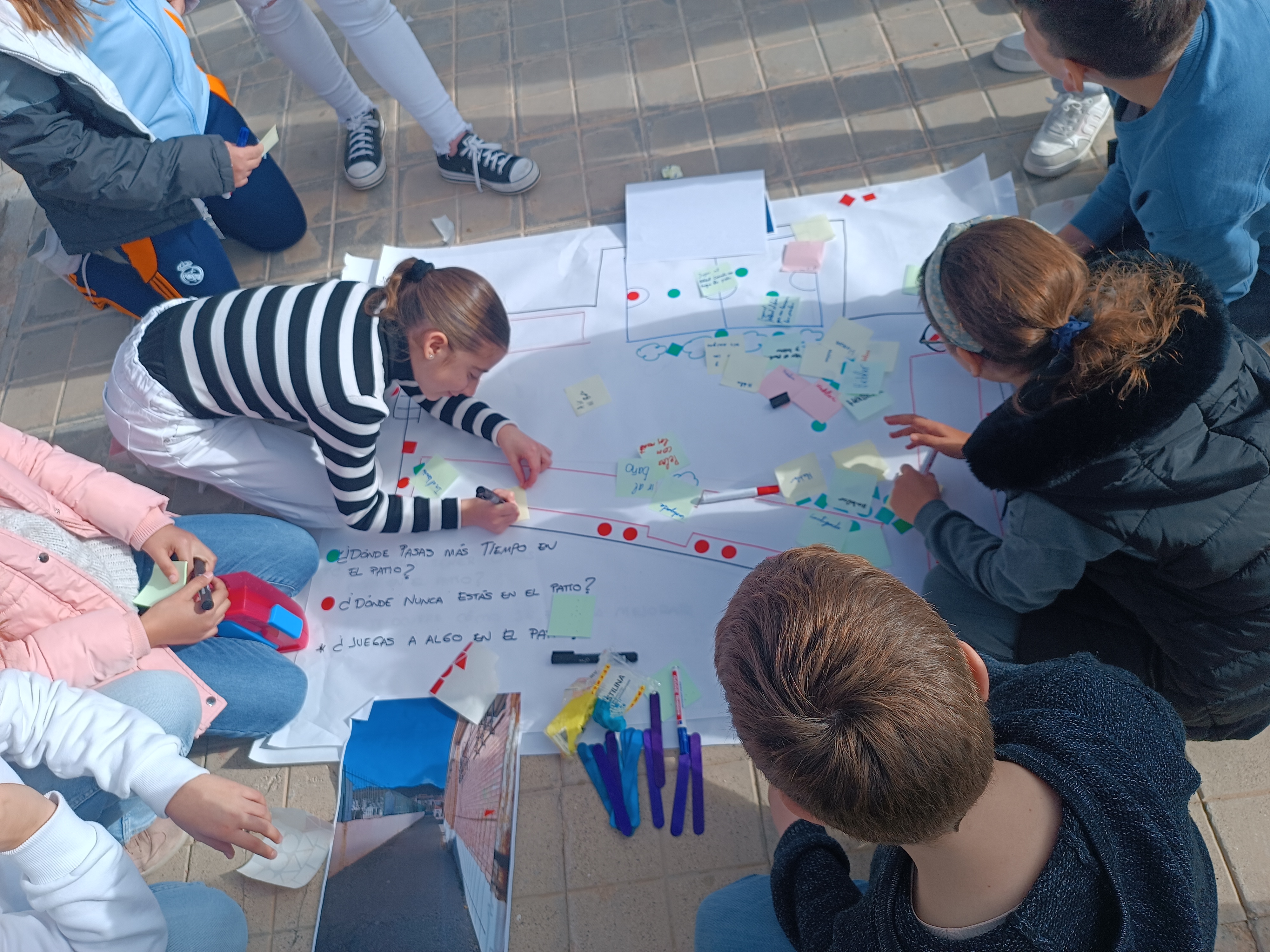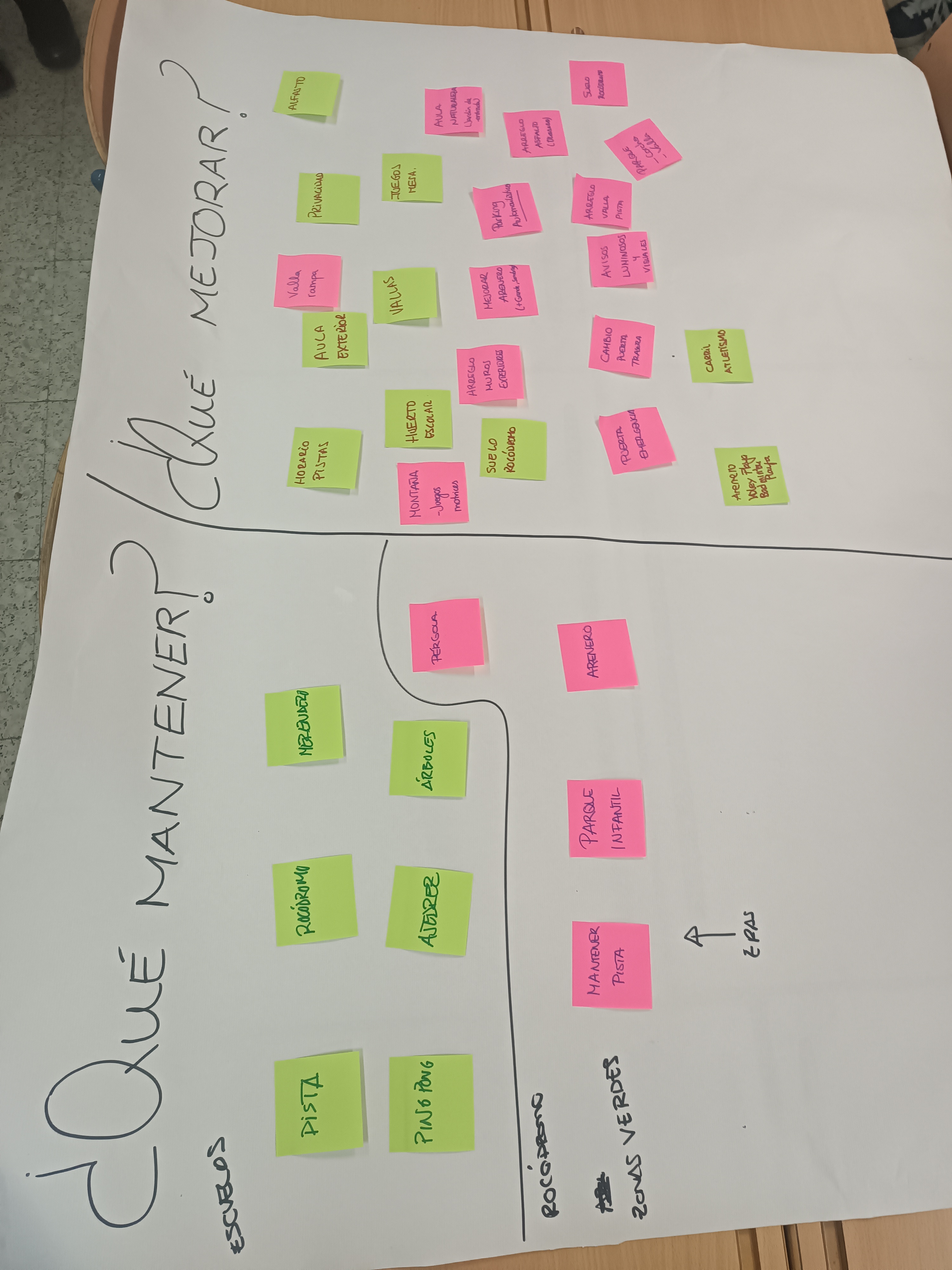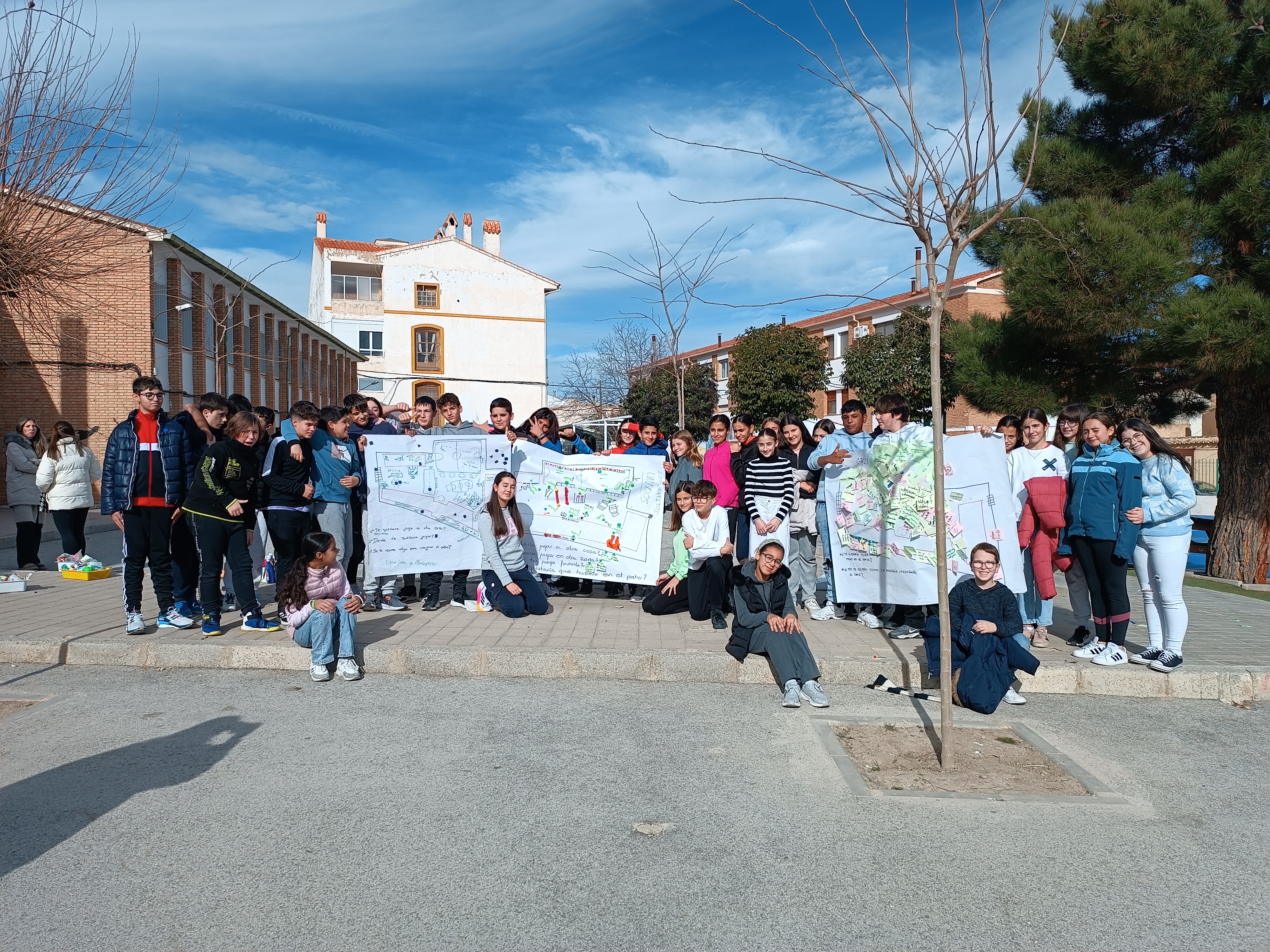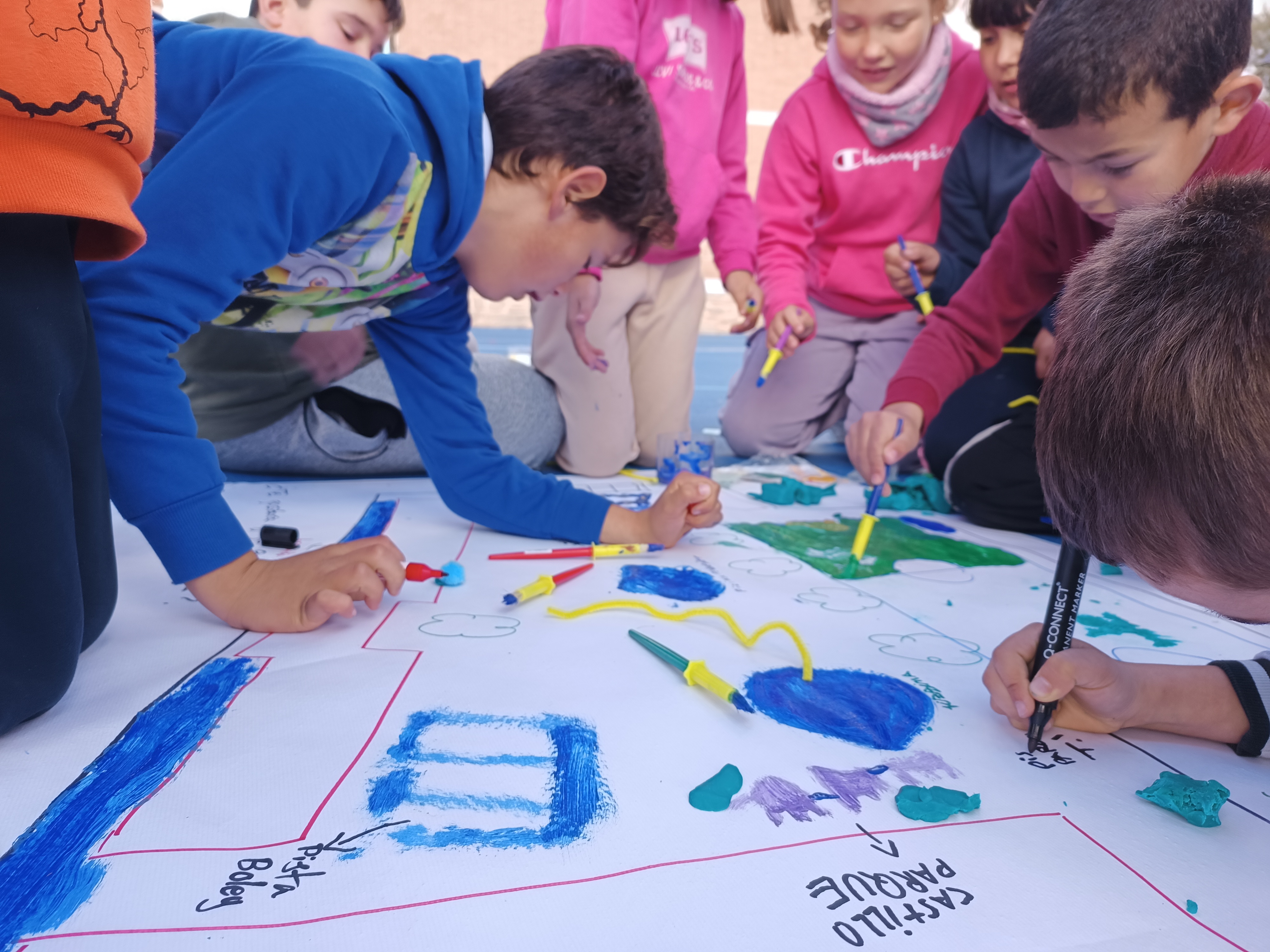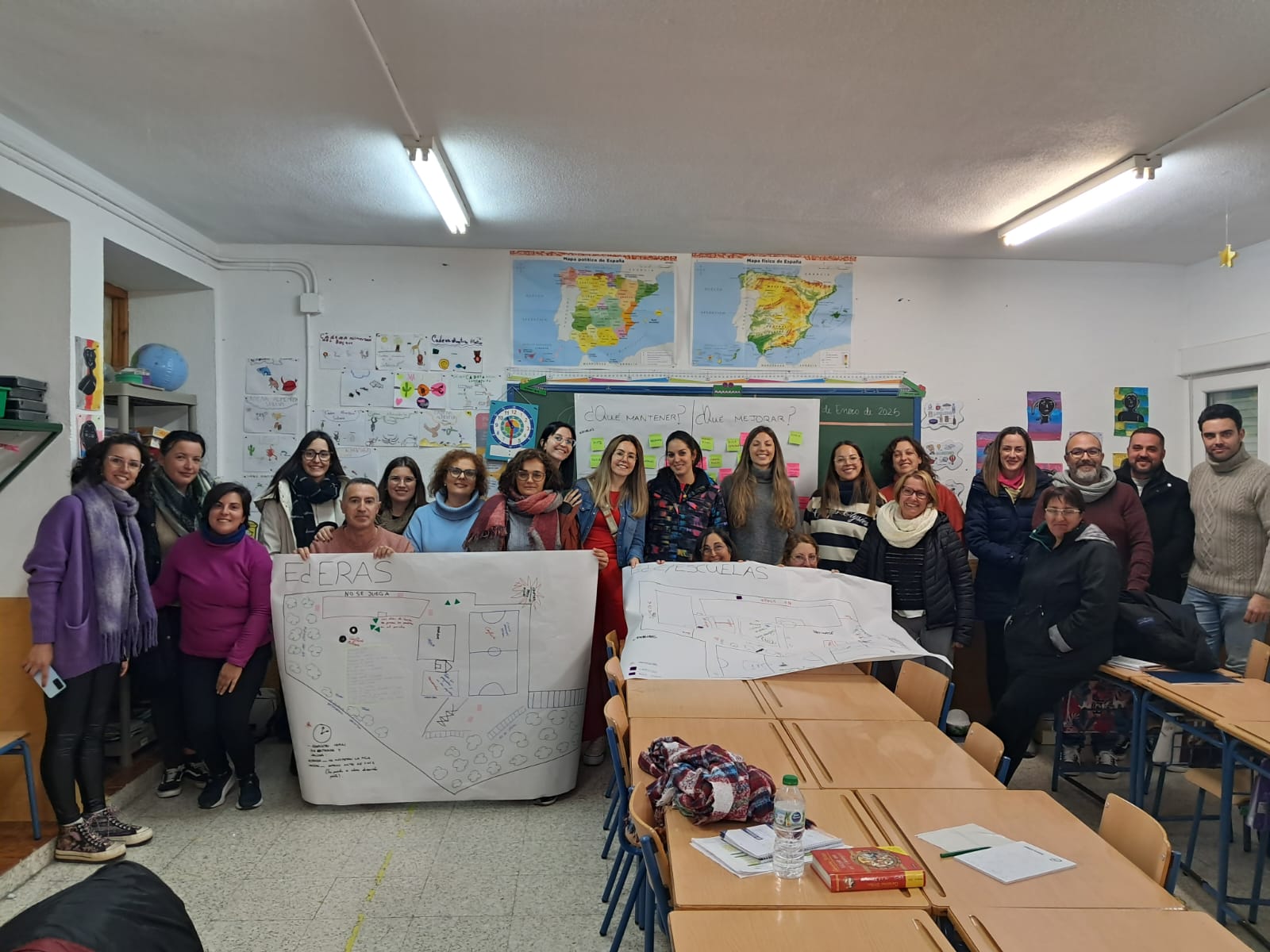Schoolyard Regeneration
Schoolyard Regeneration: Driving Change through Rural Community Participation.
The aim of the Ramón y Cajal School Playground Regeneration Project is to transform
the playgrounds of the 3 schools through a participatory process of co-creation and
shared decision-making. This process arises as a tool to address a series of challenges
detected by the educational community, related to the state of the infrastructures,
conflict over the use of space and the inclusion of different cultures.
the playgrounds of the 3 schools through a participatory process of co-creation and
shared decision-making. This process arises as a tool to address a series of challenges
detected by the educational community, related to the state of the infrastructures,
conflict over the use of space and the inclusion of different cultures.
Spain
Puebla de Don Fadrique, Granada, España
Prototype level
Yes
Yes
Yes
No
No
18164: Puebla de Don Fadrique (ES)
The aim of the Ramón y Cajal School Playground Regeneration Project is to transform
the playgrounds of the 3 schools through a participatory process of co-creation and
shared decision-making. This process arises as a tool to address a series of challenges
detected by the educational community, related to the state of the infrastructures,
conflict over the use of space and the inclusion of different cultures. Through this
process, in the form of workshops, the entire student body, from 3 to 14 years of age,
teachers and families have carried out a diagnosis of the school playground and
proposed a series of actions for its improvement from the perspective of sustainability,
inclusion and beauty.
There are many hours that children spend in the playground, and there are also many
experiences and learning experiences that take place in this space. In it, we interact,
experience conflicts and develop our social and emotional skills. It thus becomes a
space for relationships between genders, ages and cultures. We want to educate for
responsibility and co-responsibility, respect, care and autonomy, all in a participatory
way between the different groups of the educational community.
The target audiences of this project and beneficiaries are: students, teachers, families,
citizens of the municipality and indirectly other centres in other municipalities that feel
inspired by learning about this project.
Through this process, in the form of workshops, all the pupils, from 3 to 14 years old,
the teachers and the families have carried out a diagnosis of the school playground
and have proposed a series of actions for its improvement from the perspective of
sustainability, inclusion and beauty.
This project started in September 2024 and some of its phases have been developed. It
is foreseen that the intervention actions to be developed in the playground will end in
June 2026 (see chronogram in the development plan).
the playgrounds of the 3 schools through a participatory process of co-creation and
shared decision-making. This process arises as a tool to address a series of challenges
detected by the educational community, related to the state of the infrastructures,
conflict over the use of space and the inclusion of different cultures. Through this
process, in the form of workshops, the entire student body, from 3 to 14 years of age,
teachers and families have carried out a diagnosis of the school playground and
proposed a series of actions for its improvement from the perspective of sustainability,
inclusion and beauty.
There are many hours that children spend in the playground, and there are also many
experiences and learning experiences that take place in this space. In it, we interact,
experience conflicts and develop our social and emotional skills. It thus becomes a
space for relationships between genders, ages and cultures. We want to educate for
responsibility and co-responsibility, respect, care and autonomy, all in a participatory
way between the different groups of the educational community.
The target audiences of this project and beneficiaries are: students, teachers, families,
citizens of the municipality and indirectly other centres in other municipalities that feel
inspired by learning about this project.
Through this process, in the form of workshops, all the pupils, from 3 to 14 years old,
the teachers and the families have carried out a diagnosis of the school playground
and have proposed a series of actions for its improvement from the perspective of
sustainability, inclusion and beauty.
This project started in September 2024 and some of its phases have been developed. It
is foreseen that the intervention actions to be developed in the playground will end in
June 2026 (see chronogram in the development plan).
Sustainability
inclusion
beauty
educacional community
co-creation
Sustainability in our playground is based on the implementation of practices that
promote respect and care for the environment, while at the same time favouring the
well-being of students and the educational community. A sustainable school
playground is one that integrates elements that favour the conservation of natural
resources as well as improving the quality of life of those who use it.
- Vegetation and biodiversity: The planting of trees, plants and gardens is encouraged,
which not only beautify the environment, but also help to improve air quality, provide
natural shade and create a more pleasant microclimate. In addition, school gardens
have been included.
- Education and awareness: A sustainable schoolyard should also be a space where
environmental awareness is promoted among students through activities, projects and
educational programmes that teach them about sustainability and care for the planet.
Insect hotels and an open-air classroom have been proposed for this purpose.
- Waste management: Recycling and the correct disposal of waste is another key aspect,
with the inclusion of recycling and composting bins in the playground, as well as the
reuse of materials to generate play spaces (wheels and pallets).
promote respect and care for the environment, while at the same time favouring the
well-being of students and the educational community. A sustainable school
playground is one that integrates elements that favour the conservation of natural
resources as well as improving the quality of life of those who use it.
- Vegetation and biodiversity: The planting of trees, plants and gardens is encouraged,
which not only beautify the environment, but also help to improve air quality, provide
natural shade and create a more pleasant microclimate. In addition, school gardens
have been included.
- Education and awareness: A sustainable schoolyard should also be a space where
environmental awareness is promoted among students through activities, projects and
educational programmes that teach them about sustainability and care for the planet.
Insect hotels and an open-air classroom have been proposed for this purpose.
- Waste management: Recycling and the correct disposal of waste is another key aspect,
with the inclusion of recycling and composting bins in the playground, as well as the
reuse of materials to generate play spaces (wheels and pallets).
Aesthetics are key to creating an environment that is not only functional, but also
pleasant and stimulating. Our playground will have an attractive and well-kept design
to positively influence the emotional well-being of students, encouraging creativity,
relaxation and enjoyment of time.
- Natural elements: Plants, trees and flowers have been incorporated to enhance the
appearance of the playground contributing to a healthier environment, providing
shade, freshness and a natural touch.
- Bright and pleasant colours: The colours of the patio, both in the structures and in the
decorative elements, play an important role in creating a positive and stimulating
environment. Vibrant colours such as green, blue, yellow or orange convey energy and
joy.
- Art and creativity: Incorporating artistic elements, such as murals, adds a unique touch
to the playground. Students can participate in the creation of these elements, which
fosters a sense of ownership and expression.
- Welcoming spaces: Include spaces for resting, reading and playing that invite
relaxation and socialising.
pleasant and stimulating. Our playground will have an attractive and well-kept design
to positively influence the emotional well-being of students, encouraging creativity,
relaxation and enjoyment of time.
- Natural elements: Plants, trees and flowers have been incorporated to enhance the
appearance of the playground contributing to a healthier environment, providing
shade, freshness and a natural touch.
- Bright and pleasant colours: The colours of the patio, both in the structures and in the
decorative elements, play an important role in creating a positive and stimulating
environment. Vibrant colours such as green, blue, yellow or orange convey energy and
joy.
- Art and creativity: Incorporating artistic elements, such as murals, adds a unique touch
to the playground. Students can participate in the creation of these elements, which
fosters a sense of ownership and expression.
- Welcoming spaces: Include spaces for resting, reading and playing that invite
relaxation and socialising.
Inclusion in our playground is about recognising and addressing the different needs of
students to ensure they have equal opportunities to participate and enjoy the space. It
is an inclusive approach that seeks to create a school environment where everyone
feels valued and respected.
- Accessibility for all: The playground is designed so that all students, regardless of their
physical abilities or limitations, can access the facilities and participate in activities.
- Support for diversity of abilities: Students with different levels of physical, mental or
emotional abilities may need specific supports to participate in games or activities.
- Promoting inclusion: In an equitable environment, active measures are taken to
ensure that all students, regardless of cultural background, gender, sexual orientation
or socio-economic status, feel part of the group.
- Encourage active participation: Equity in a schoolyard also manifests itself in ensuring
that everyone plays an active role in activities, promoting teamwork and mutual
respect.
students to ensure they have equal opportunities to participate and enjoy the space. It
is an inclusive approach that seeks to create a school environment where everyone
feels valued and respected.
- Accessibility for all: The playground is designed so that all students, regardless of their
physical abilities or limitations, can access the facilities and participate in activities.
- Support for diversity of abilities: Students with different levels of physical, mental or
emotional abilities may need specific supports to participate in games or activities.
- Promoting inclusion: In an equitable environment, active measures are taken to
ensure that all students, regardless of cultural background, gender, sexual orientation
or socio-economic status, feel part of the group.
- Encourage active participation: Equity in a schoolyard also manifests itself in ensuring
that everyone plays an active role in activities, promoting teamwork and mutual
respect.
This school playground regeneration project has been based on a participatory process of co-
creation of the actions to be implemented by the entire educational community of the
municipality. The process consisted of a diagnostic phase, a participatory proposal phase and
the definition of a general action project. This co-created decision-making process makes the
people who have participated feel part of the project, get involved in the implementation and
take care of the actions that are implemented in the long term.
creation of the actions to be implemented by the entire educational community of the
municipality. The process consisted of a diagnostic phase, a participatory proposal phase and
the definition of a general action project. This co-created decision-making process makes the
people who have participated feel part of the project, get involved in the implementation and
take care of the actions that are implemented in the long term.
During the participatory process for the regeneration of the school playground, there has been
interaction between different groups: pupils from all levels of the school, the teaching staff
and the pupil´s families. Each of these groups contributed their vision, challenges and needs,
which enriched the process. The aim was to gather everyone´s ideas, with the common
objective of transforming and improving the school playground, creating a more inclusive and
appropriate space.
interaction between different groups: pupils from all levels of the school, the teaching staff
and the pupil´s families. Each of these groups contributed their vision, challenges and needs,
which enriched the process. The aim was to gather everyone´s ideas, with the common
objective of transforming and improving the school playground, creating a more inclusive and
appropriate space.
The process of regenerating the school playground has involved the participation of
professionals from various fields, which has greatly enriched the initiative. From teachers to
the different profiles within the families that have been part of the project, such as
photographers, bakers, doctors, businessmen, civil servants, lawyers, cleaners, farmers,
livestock breeders, hunters and cooks. Each of these professionals has contributed their
experience and knowledge, making a valuable contribution to the design and transformation
of the school space.
professionals from various fields, which has greatly enriched the initiative. From teachers to
the different profiles within the families that have been part of the project, such as
photographers, bakers, doctors, businessmen, civil servants, lawyers, cleaners, farmers,
livestock breeders, hunters and cooks. Each of these professionals has contributed their
experience and knowledge, making a valuable contribution to the design and transformation
of the school space.
The participatory process for the transformation of the school playground represents an
innovative project by moving away from conventional practices. Instead of imposing a
predetermined design, we have opted for a collaborative approach that involves the entire
educational community: students, teachers, families and professionals from different areas.
This participatory approach not only fosters creativity and inclusion, but also allows us to
generate a space that is more adapted to the real needs of all those involved, promoting a
dynamic, flexible environment in line with new pedagogical and social trends.
innovative project by moving away from conventional practices. Instead of imposing a
predetermined design, we have opted for a collaborative approach that involves the entire
educational community: students, teachers, families and professionals from different areas.
This participatory approach not only fosters creativity and inclusion, but also allows us to
generate a space that is more adapted to the real needs of all those involved, promoting a
dynamic, flexible environment in line with new pedagogical and social trends.
The participatory methodology for decision-making in schoolyard design focuses on the active collaboration of various members of the school community (students, teachers, administrative staff, parents, etc.) to create a space that responds to their needs and realities. It promotes a democratic and inclusive vision where all voices are heard and integrated.
This participatory process is based on Otto Scharmer’s U Theory, which centers on transformation in decision-making processes. The theory unfolds in three key stages: co-creation and co-development of solutions. The process follows a "U" shape, starting with clarity, then delving deeper into understanding, and finally emerging with new perspectives and innovative solutions.
The stages of the process applied to schoolyard design are:
1. Descending the "U" (Co-creation and Deep Understanding): Deep listening, observation, and context analysis. Goal: Understand what needs to change.
2. The Bottom of the "U" (Empowerment and Creativity): Suspension of judgment, openness to the emerging future, idea generation, and prototyping. Goal: Create new ideas for the schoolyard.
3. Rising from the "U" (Co-creation of the Future and Action): Collective action, prototyping and adjustments, evaluation, and feedback. Goal: Materialize the design with flexibility for adaptations.
Key features include: a) Inclusivity, b) Future vision, c) Co-creation and adaptation, d) Focus on well-being. Applying U Theory to schoolyard design fosters collaboration, transforming the space into one that promotes belonging, safety, and creativity.
This participatory process is based on Otto Scharmer’s U Theory, which centers on transformation in decision-making processes. The theory unfolds in three key stages: co-creation and co-development of solutions. The process follows a "U" shape, starting with clarity, then delving deeper into understanding, and finally emerging with new perspectives and innovative solutions.
The stages of the process applied to schoolyard design are:
1. Descending the "U" (Co-creation and Deep Understanding): Deep listening, observation, and context analysis. Goal: Understand what needs to change.
2. The Bottom of the "U" (Empowerment and Creativity): Suspension of judgment, openness to the emerging future, idea generation, and prototyping. Goal: Create new ideas for the schoolyard.
3. Rising from the "U" (Co-creation of the Future and Action): Collective action, prototyping and adjustments, evaluation, and feedback. Goal: Materialize the design with flexibility for adaptations.
Key features include: a) Inclusivity, b) Future vision, c) Co-creation and adaptation, d) Focus on well-being. Applying U Theory to schoolyard design fosters collaboration, transforming the space into one that promotes belonging, safety, and creativity.
The participatory process for the transformation of the schoolyard has been conceived as a
transferable project, with a high capacity for replicability in other schools and as a source of
inspiration for other schools to develop it. The methodology used, based on the active
collaboration of the whole school community, can be adapted and applied in different
contexts, allowing other institutions to benefit from the accumulated experience. This
approach not only fosters innovation in each school space, but also establishes a model that can be replicated to create more inclusive, creative and functional playgrounds in diverse
educational settings, strengthening the impact of such initiatives.
The production of a video recounting the process is an inspirational tool for other schools.
transferable project, with a high capacity for replicability in other schools and as a source of
inspiration for other schools to develop it. The methodology used, based on the active
collaboration of the whole school community, can be adapted and applied in different
contexts, allowing other institutions to benefit from the accumulated experience. This
approach not only fosters innovation in each school space, but also establishes a model that can be replicated to create more inclusive, creative and functional playgrounds in diverse
educational settings, strengthening the impact of such initiatives.
The production of a video recounting the process is an inspirational tool for other schools.
Participation in the transformation of schoolyards can address several global challenges by actively involving the educational community and promoting sustainable and social changes. It helps strengthen community involvement and empowerment by fostering a sense of belonging and encouraging collaboration and collective decision-making, which in turn enhances social cohesion. By encouraging participation, inequalities in access to quality spaces can be reduced, ensuring all children, regardless of background, have access to safe and stimulating environments for their development.
The integration of sustainability in schoolyard designs, such as using recycled materials, creating school gardens, reforestation, and installing rainwater collection systems, helps raise awareness of environmental responsibility. This involvement encourages environmental education and fosters an understanding of climate change and sustainability among students and families.
Moreover, transforming schoolyards promotes a culture of peace and coexistence by creating more inclusive spaces where respect, cooperation, and peaceful conflict resolution are encouraged. It also contributes to the mental health and well-being of students by providing a sense of achievement and creating peaceful spaces for relaxation, reducing stress, and enhancing emotional support.
Lastly, this process helps students develop essential social skills and leadership qualities, such as teamwork, problem-solving, effective communication, and leadership. These skills are valuable not only in their school life but also in their future personal and professional lives. Additionally, by actively participating in designing eco-friendly school environments, students gain a deeper understanding of environmental issues and the importance of sustainability.
The integration of sustainability in schoolyard designs, such as using recycled materials, creating school gardens, reforestation, and installing rainwater collection systems, helps raise awareness of environmental responsibility. This involvement encourages environmental education and fosters an understanding of climate change and sustainability among students and families.
Moreover, transforming schoolyards promotes a culture of peace and coexistence by creating more inclusive spaces where respect, cooperation, and peaceful conflict resolution are encouraged. It also contributes to the mental health and well-being of students by providing a sense of achievement and creating peaceful spaces for relaxation, reducing stress, and enhancing emotional support.
Lastly, this process helps students develop essential social skills and leadership qualities, such as teamwork, problem-solving, effective communication, and leadership. These skills are valuable not only in their school life but also in their future personal and professional lives. Additionally, by actively participating in designing eco-friendly school environments, students gain a deeper understanding of environmental issues and the importance of sustainability.
The municipality is located in a rural area of south-eastern Spain, and faces, a number of challenges that put its development and well-being and that of future generations at risk. Climate change and desertification seriously affect its natural resources, while the loss of biodiversity weakens its ecosystem and productive capacity. Depopulation and lack of job opportunities aggravate the situation, with high unemployment limiting economic growth and social stability. This is compounded by a lack of inspiration and motivation in the community, making it difficult to generate new ideas and projects. The lack of collaboration between inhabitants and the lack of experience in decision-making processes and citizen participation prevent the achievement of collective and sustainable solutions, hindering the progress of these territories. There is economic and social inequality between different groups in society, with immigrants and the gipsy population being the groups to which these challenges are most relevant. This project aims to implement measures to address some of the challenges faced by rural municipalities, focusing on children, teachers and families, who have been identified as the key groups to bring about the necessary change. Involving these groups in decision-making
through a process of co-creation has several benefits: 1) it brings the educational community
together and promotes a dynamic of empowerment of the different agents, encouraging
constant reflection; 2) it improves coexistence, favours student play and promotes
environmental sustainability; 3) it makes the educational community feel that it has the
capacity to decide on the future of its centre, encouraging joint work for its improvement. This
participatory approach seeks to transform not only the physical space, but also the way
members of the school community relate and collaborate. 4) It addresses the cultural conflicts
that arise in the school between different social groups.
through a process of co-creation has several benefits: 1) it brings the educational community
together and promotes a dynamic of empowerment of the different agents, encouraging
constant reflection; 2) it improves coexistence, favours student play and promotes
environmental sustainability; 3) it makes the educational community feel that it has the
capacity to decide on the future of its centre, encouraging joint work for its improvement. This
participatory approach seeks to transform not only the physical space, but also the way
members of the school community relate and collaborate. 4) It addresses the cultural conflicts
that arise in the school between different social groups.

